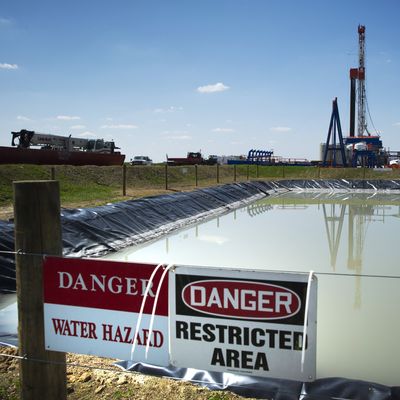
In 2015, the Environmental Protection Agency released its initial findings from five years of research into the potential hazards of hydraulic fracturing — that new hotness in energy extraction that involves pumping a cocktail of water, minerals, and chemicals into the ground to fracture shale rock and liberate the fossil fuels lying beneath. (The cool kids call it “fracking.”)
Energy executives do not, as a rule, list EPA reports among their most beloved reading materials. But there was one sentence in the agency’s 2015 report that oil barons found so beautiful, they took to reciting as though it were their favorite line from The Fountainhead: “Hydraulic fracturing activities have not led to widespread, systemic impacts to drinking water resources.”
That sentence became ubiquitous in energy-industry groups’ messaging on fracking’s safety, and in media discussions of the topic.
This development was very good for the fracking business, but very bad for the accuracy of public discourse — because the EPA had no hard data to back up its widely cited conclusion.
In fact, that conclusion had been added to the report at the last minute, according to drafts obtained by Marketplace and APM Reports. Before the report went through its final revisions, it had emphasized the two dozen cases in which the agency had linked fracking to water contamination.
Instead, the publicly issued draft took the fact that researchers lacked the data to prove that fracking has had “systemic impacts” on drinking water, and framed it as a firm conclusion that the extraction method has not done so.
“We suggested that they provide a definition of ‘systemic,’ a definition of ‘widespread’ and then provide quantitative data to support the conclusion,” Peter Thorne, chairman of the EPA’s Science Advisory Board, told Marketplace and APM. “That is all a way of asking them to put that kind of scientific rigor behind a statement as broad as that.”
The EPA seems to have taken Thorne’s advice. This week, the agency released the final version of their 2015 report on fracking — and the energy industry’s favorite sentence was nowhere to be found.
“E.P.A. scientists chose not to include that sentence. The scientists concluded it could not be quantitatively supported,” Thomas A. Burke, the EPA’s science adviser, told the New York Times.
Among the conclusions that can be quantitatively supported: Fracking has been found — in various instances — to contaminate drinking water during all stages in its process, which the EPA describes as follows:
(1) acquiring water to be used for hydraulic fracturing (Water Acquisition), (2) mixing the water with chemical additives to make hydraulic fracturing fluids (Chemical Mixing), (3) injecting hydraulic fracturing fluids into the production well to create and grow fractures in the targeted production zone (Well Injection), (4) collecting the wastewater that returns through the well after injection (Produced Water Handling), and (5) managing the wastewater through disposal or reuse methods (Wastewater Disposal and Reuse).
So, there’s significant evidence that fracking can contaminate water, at least where it’s executed poorly. However, the EPA could not come to any solid conclusions about how severe or widespread these instances of contamination are.
“In places where we know activities in the hydraulic fracturing water cycle have occurred, data that could be used to characterize hydraulic fracturing-related chemicals in the environment before, during, and after hydraulic fracturing were scarce,” the agency says in a news release. “Because of these data gaps and uncertainties, as well as others described in the assessment, it was not possible to fully characterize the severity of impacts, nor was it possible to calculate or estimate the national frequency of impacts on drinking water resources from activities in the hydraulic fracturing water cycle.”
There appear to be at least two lessons here:
1. More research into fracking’s impact on drinking water is needed.
2. The EPA needs to resist the temptation to characterize its findings in ways that won’t make the energy industry apoplectic.
Is there any reason to doubt that the Trump administration will heed these lessons?






























